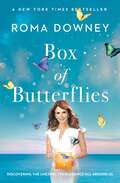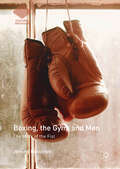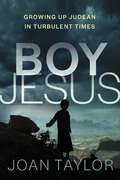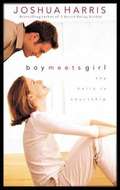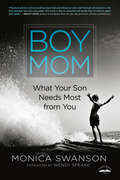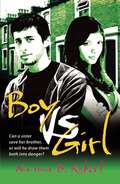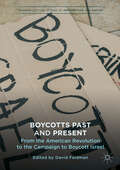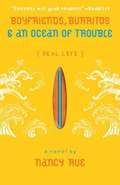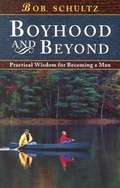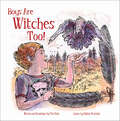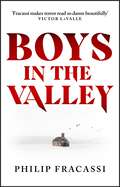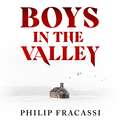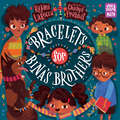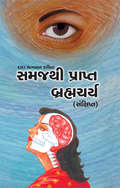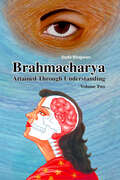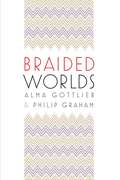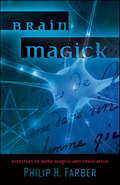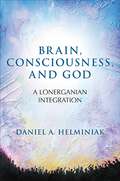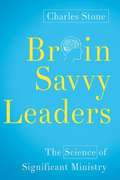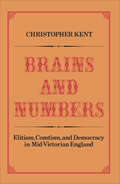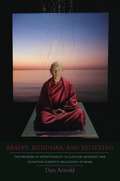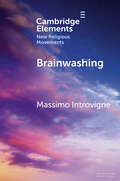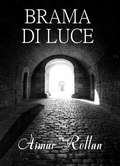- Table View
- List View
Box of Butterflies: Discovering the Unexpected Blessings All Around Us
by Roma DowneyA NEW YORK TIMES BESTSELLER Roma Downey—best known as the beloved angel on the TV show Touched by an Angel—&“has created a beautiful and personal testimony to the presence of God in our lives and our world&” (Most Reverend José H. Gomez, Archbishop of Los Angeles).Ever since she was a little girl, Roma has seen butterflies as a reminder of God&’s presence. They have appeared to her in moments when she needed encouragement, reminding her that she is not alone. In this deeply personal book, Roma shares stories from her life, alongside quotes, poems, scripture, and artwork that she prays will uplift you as they have her. Reminiscent of the message of her popular television series, Touched by an Angel, this book&’s central theme is that there is a God, He loves you, and that even in your most difficult moments, He is by your side. The subtle butterfly theme reminds us that the wonder of God&’s love and kindness is sometimes reflected in the gentle whispers of His creation and that we all have the power to transform from simple caterpillars into exquisite butterflies. This inspirational book invites you to return to its pages again and again, as life brings new challenges, or you find yourself in need of new inspiration. Box of Butterflies &“will touch you and move you and strengthen you&” (Kathie Lee Gifford).
Boxing, the Gym, and Men: The Mark of the Fist (Cultural Sociology)
by Jérôme BeauchezThis book explores the lived experiences of boxers in a French banlieue, largely populated by people from working-class and immigrant backgrounds. Jérôme Beauchez, who joined in the men’s daily workouts for many years, analyzes the act of boxing as a high-stakes confrontation that extends well beyond the walls of the gym. Exploring the physical and existential realities of combat, the author provides a multifaceted “thick description” of this world and shows that the violence faced by the gym’s members is not so much to be found in the ring as in the adversity of everyday racism and social exclusion. Boxing can therefore be understood as an act of resistance that is about more than simply fighting an opponent and that reflects all the existential struggles facing these men who are both stigmatized and socially dominated by race and class.
Boy Jesus: Growing Up Judean in Turbulent Times
by Joan TaylorAs a boy, Jesus was a refugee, an outsider, an immigrant in Galilee in which he grew up, and affected by horrific atrocities by the occupying Roman overlords.All this and more is explored in this scholarly but highly accessible investigation into the world of Jesus, ranging from his birth to his coming of age and beyond. Joan Taylor, a world authority on the history and literature of the first century CE, draws both on the latest archaeological findings and on the historical clues to be found within ancient texts of the period. The result is a book that brings the story of Jesus' childhood clearly and vividly to life as never before, while also pointing to the many ways in which Jesus' experiences as a child are likely to have influenced his life, attitudes, and actions as an adult.
Boy Mom: What Your Son Needs Most from You
by Monica SwansonThis guidebook, packed with wisdom, practical advice, resources, and encouragement, explores how moms can equip their sons with what they most need to succeed in life.Monica Swanson knew she'd tapped a heartfelt concern when nearly two million readers shared her blog post "What a Teenage Boy Needs Most from His Mom." In this helpful book, she takes mothers deeper into the insights they need for the boy-raising journey, covering topics from dealing with the daily influences of friends and technology to helping a boy grow to be physically, spiritually, and emotionally healthy. She also addresses learning and finding passions, perspectives on relationships and dating, and work ethics and money management. Each chapter features relatable stories, handy checklists, and practical advice based on a combination of research, experience, and biblical truth to guide and equip a mom in helping her son achieve his God-given potential.
Boy vs. Girl
by Na'Ima B. RobertFarhana and Faraz are twins, born 6 minutes apart. Both are in turmoil as they approach the holy time of Ramadan. Farhana has to decide whether her faith is strong enough for her to wear the hijab at school and whether she can give up her relationship with handsome Malik. Faraz has fallen in with a street gang headed by unscrupulour Skrooz, when all he really wants is to combine his faith and his talent for art. Both teenagers have life-changing choices to make, against the peaceful backdrop of Ramadan. Do Farhana and Faraz have enough courage to do the right thing? And can they help each other - or will one of them draw the other towards catastrophe? When Faraz finally says no to the drug-dealing demands of Skrooz, it sets off a dangerous chain of events. This powerful novel explores ideas of right and wrong, and honour, and what they mean to different generations of Muslim families living in the west.
Boycotts Past and Present: From the American Revolution to the Campaign to Boycott Israel (Palgrave Critical Studies of Antisemitism and Racism)
by David FeldmanIn this book historians and social scientists examine boycotts from the eighteenth century to the present day. Employed in struggles against British rule in the American colonies, against racial discrimination in the United States during the Civil Rights movement, and Apartheid in South Africa, today it is Israel that is the focus of a campaign for Boycott, Divestment and Sanctions (BDS). Boycotts have featured in campaigns undertaken by labour, consumer and nationalist movements. Jews were the focus of some boycotts instigated by nationalist movements in Central and Eastern Europe and Jewish businesses were targeted by the National Socialist regime in Germany. In this collection, contributors explore the history of past boycott movements and examine the different narratives put forward by proponents and opponents of the current BDS movement directed against Israel: one which places the movement within a history of struggles for ‘human rights’; the other which regards BDS as the latest manifestation of an antisemitic tradition.
Boyfriends, Burritos, and an Ocean of Trouble (Real Life #2)
by Nancy RueSecrets? Bryn O'Connor is good at keeping secrets. But when a car accident reveals her boyfriend's abusive behavior, the truth is unleashed. And it starts a tidal wave of trouble in Bryn's life: enemies who were once friends, a restraining order violation, and her world unraveled. If that weren't enough, her grandmother Mim arrives, attempting Mexican cuisine and insisting that Bryn try surfing. It's all too much! Even Bryn's habit of daydreaming won't offer an escape this time. But could a mysterious book she found hold the secret to riding a tsunami like her life?
Boyhood And Beyond
by Schultz BobBoys who are on the road to becoming men of honor, courage, and faith will greatly benefit from the heartfelt encouragement and sound advice offered in Boyhood and Beyond. Wisdom and common sense are gleaned from short chapters covering topics such as authority, inventiveness, and honesty as well as learning to overcome things like fear, laziness, and temptation. Boyhood and Beyond motivates boys to build their lives on a foundation of strong moral principles. Most importantly, these chapters will encourage boys to become the men God wants them to be as they develop a relationship with Him. This is a "life" book designed to be read and lived out in a boy's life, thus becoming one of his building blocks to godly character and, ultimately, manhood. Boyhood and Beyond can be read alone, used with a journal, or read aloud in a group. There are discussion questions at the end of each chapter. Ages 10-18.
Boys Are Witches Too!
by Ted EnikThis richly illustrated, rhyming ABC book, a sequel to Wee Witches, explores Witchcraft through boys' experiences Explore a magical world where Witchcraft welcomes all. This rhyming ABC book celebrates the beauty of both the Goddess and God energies while following the alphabet. A is for Apple, F is for Forest, R is for Raven, Z is for Zodiac. Discover the hidden wisdom behind these 26 enchantingly illustrated entries as you uncover the mysteries of the Craft. Immerse yourself in this richly illustrated book, perfect for pagan kids and their families. Boys Are Witches Too! takes you on a journey through the mystical "Wheel of the Year" and the wonders of nature magic, inspiring readers to connect with the elements and the world around them. Let Boys Are Witches Too! be your guide on a magical journey, discovering Witchery's natural wonders from A to Z.
Boys in the Valley
by Philip Fracassi'The terror's exquisite. Fracassi's got his hand on the chisel going into your chest' Stephen Graham Jones, author of The Only Good IndiansSt. Vincent's Orphanage for Boys. Turn of the century, in a remote valley in Pennsylvania. Here, under the watchful eyes of several priests, thirty boys work, learn, and worship. Peter Barlow, orphaned as a child by a gruesome murder, has made a new life here. As he approaches adulthood, he has friends, a future. . . a family. Then, late one stormy night, a group of men arrive at their door, one of whom is badly wounded, occult symbols carved into his flesh. His death releases an ancient evil that spreads like sickness, infecting St. Vincent's and the children within. Soon, boys begin acting differently, forming groups. Taking sides. Others turn up dead. Now Peter and those dear to him must choose sides of their own, each of them knowing their lives - and perhaps their eternal souls - are at risk.The Exorcist meets Lord of the Flies, by way of Midnight Mass, Boys in the Valley is a chilling folk horror set in a remote orphanage in turn of the century Pennsylvania.Praise for Boys in the Valley:'Fracassi makes terror read so damn beautifully' Victor LaValle, author of The Changeling'An unrelenting and highly entertaining show of horrors' Thomas Olde Heuvelt, author of Hex'A smart and deftly-written tale instilled with the kind of creeping, claustrophobic horror I enjoy' Nick Cutter, author of The Troop'As poignant as it is chilling, with a fast-paced, unflinching ending' Alma Katsu, author of The Hunger'The most unsettling novel I have read all year. Cold dread clings to every page' Ronald Malfi, author of Black Mouth'Harrowing and claustrophobic' Christopher Golden, author of Road of Bones'Fracassi. . . builds his horrific tales slowly and carefully...he's especially skilful at creating, and sustaining, suspense' The New York Times'Gut-wrenching, heart breaking, and terrifying' Andy Davidson, author of The Boatman's Daughter'Horror readers will be hooked' Publishers Weekly'A riveting, and horrifying, tale of survival set against a punishing and vivid backdrop.' Victor LaValle'Fracassi. . . brings a depth of understanding to his monsters, human and otherwise' Guardian'Fracassi's storytelling is. . . horror with a big, broken heart' Esquire'His range, prolific output, and fast-paced prose are all set to put him on the shelf next to names such as King, Straub, and Thomas Harris' Signal Horizon
Boys in the Valley
by Philip Fracassi'The terror's exquisite. Fracassi's got his hand on the chisel going into your chest' Stephen Graham Jones, author of The Only Good IndiansSt. Vincent's Orphanage for Boys. Turn of the century, in a remote valley in Pennsylvania. Here, under the watchful eyes of several priests, thirty boys work, learn, and worship. Peter Barlow, orphaned as a child by a gruesome murder, has made a new life here. As he approaches adulthood, he has friends, a future. . . a family. Then, late one stormy night, a group of men arrive at their door, one of whom is badly wounded, occult symbols carved into his flesh. His death releases an ancient evil that spreads like sickness, infecting St. Vincent's and the children within. Soon, boys begin acting differently, forming groups. Taking sides. Others turn up dead. Now Peter and those dear to him must choose sides of their own, each of them knowing their lives - and perhaps their eternal souls - are at risk.The Exorcist meets Lord of the Flies, by way of Midnight Mass, Boys in the Valley is a chilling folk horror set in a remote orphanage in turn of the century Pennsylvania.Praise for Boys in the Valley:'Fracassi makes terror read so damn beautifully' Victor LaValle, author of The Changeling'An unrelenting and highly entertaining show of horrors' Thomas Olde Heuvelt, author of Hex'A smart and deftly-written tale instilled with the kind of creeping, claustrophobic horror I enjoy' Nick Cutter, author of The Troop'As poignant as it is chilling, with a fast-paced, unflinching ending' Alma Katsu, author of The Hunger'The most unsettling novel I have read all year. Cold dread clings to every page' Ronald Malfi, author of Black Mouth'Harrowing and claustrophobic' Christopher Golden, author of Road of Bones'Fracassi. . . builds his horrific tales slowly and carefully...he's especially skilful at creating, and sustaining, suspense' The New York Times'Gut-wrenching, heart breaking, and terrifying' Andy Davidson, author of The Boatman's Daughter'Horror readers will be hooked' Publishers Weekly'A riveting, and horrifying, tale of survival set against a punishing and vivid backdrop.' Victor LaValle'Fracassi. . . brings a depth of understanding to his monsters, human and otherwise' Guardian'Fracassi's storytelling is. . . horror with a big, broken heart' Esquire'His range, prolific output, and fast-paced prose are all set to put him on the shelf next to names such as King, Straub, and Thomas Harris' Signal Horizon
Bracelets for Bina's Brothers (Storytelling Math)
by Rajani LaRoccaCelebrate diversity, math, and the power of storytelling!For the Hindu holiday of Raksha Bandhan, Bina is determined to make beaded bracelets for her brothers all by herself. She finds out which colors her brothers like and dislike and sets to work. Working with her every-other-one beading pattern causes Bina to discover something new about patterns--and her brothers.Storytelling Math celebrates children using math in their daily adventures as they play, build, and discover the world around them. Joyful stories and hands-on activities make it easy for kids and their grown-ups to explore everyday math together. Developed in collaboration with math experts at STEM education nonprofit TERC, under a grant from the Heising-Simons Foundation.
Brahmacharya (Sanxipt): બ્રહ્મચર્ય (સંક્ષિપ્ત)
by Dada Bhagwanતમને ચોરી કરવી ગમે? તમને જુઠું બોલવું ગમે? તમને કોઈને મારી નાખવાનું (હિંસા) ગમે? તો પછી વિષયમાં એવું શું છે કે તે પોતાને ગમે છે? તે ફક્ત રોંગ બિલીફના કારણે છે. બીજાઓએ કહ્યું તેથી તમે પણ માનો છો કે વિષયમાં પરમ સુખ છે. પણ તે સત્ય નથી. સ્વાભાવિક રીતે વિચારો, શું તમારી બીજી ઇન્દ્રિયોને તે ગમે છે? શું આંખોને તે ગમે છે? શું કાનો સાંભળે છે ત્યારે તેમને તે ગમે છે? શું જીભ ચાટે તો તે મીઠું લાગે છે? નાકને તે ખરેખર ગમતું હશે, નહિ? કોઈ પણ ઇન્દ્રિયને તે ગમતું નથી. દરેક માણસે વિષયનું પરીણામ શું છે અને બ્રહ્મચર્ય પાળવાના શા ફાયદા છે તે ઓળખવા જોઈએ. પોતાના કાયદેસરના સાથીદાર સાથે પણ ફક્ત એક વખત વિષય ભોગવવાથી, લાખો જીવોની હિંસા થાય છે; અને પોતાના લગ્નના સાથીદાર સિવાય બીજા કોઈ સાથેનો વિષય નરકમાં જવાનું કારણ છે. દરેક જણ સહમત થાય છે કે બ્રહ્મચર્ય પાળવું જોઈએ. પરંતુ તે પાળવું કેમ? કોઈએ કદી તેનો રસ્તો બતાવ્યો નથી. આ પુસ્તકમાં તમે જોશો કે બ્રહ્મચર્ય પાળવાના સચોટ અને સ્પષ્ટ રસ્તા બતાવ્યા છે. વર્તમાન અને ભવિષ્યના વિષયના ભયંકર જોખમ વાંચીને લોકોને ધક્કો લાગશે અને તેઓ કહેશે “અમને આની જાણ જ ન હતી.”
Brahmacharya Attained Through Understanding (Volume Two)
by Dada BhagwanEach and every human being has the capacity to identify his Soul and attain salvation. However, one severe obstacle on this path could be sexual attraction/ infatuation. None other than a Gnani Purush (the enlightened one) can help us understand the science behind sexual attraction and help us get rid of it. In the book, Dadashri, the Gnani Purush has discussed the importance of celibacy in the path of salvation…and how it can be achieved even by the married couples. The nature of sexuality, its present life dangers, as well as potential dangers for the lives to come are described by the Gnani and the beneficial effects of brahmacharya are shown with scientific exactness. Precise understanding of brahmacharya, methods by eradicating the root cause of sexuality, is given to the seeker. In part 1 of the book, Dadashri has warned the married people of infidelity (by thoughts and actions), explained the risks thereof, emphasized on how the subtlest form of infidelity/attraction would divert us from the path of spirituality. For married people, remaining utmost faithful to his/her partner is equivalent to celibacy. In part 2 of the book, Dadashri, has discussed about his enlightened Self that moves about unbound by any circumstance of the material world, unveils for us all ! He initiates the cause brahmacharya in the light of this absolute vision and experiential bliss for all who come to him seeking freedom from the clutches of sexuality and its misery. In this environment rampant with profuse sexuality and its vibrations, the Gnani Purush’s extraordinary and effective speech demolishes all elements of sexuality and illusion of the seeker and makes him still in brahmacharya with understanding.
Brahmacharya: Celibacy Attained With Understanding
by Dada BhagwanIn the book “Brahmacharya: Celibacy With Right Understanding”, Gnani Purush (embodiment of Self knowledge) Dada Bhagwan offers unique insight into the definition of celibacy and the benefits of brahmacharya.He clarifies common misunderstandings about celibacy, answering questions such as: “How do you define celibacy?”, “What are the spiritual reasons for abstinence from sex, and what are the benefits of abstinence?”, “Does spiritual power increase from brahmacharya, and how is celibacy related to spirituality and practice?”, “Must one take a vow of celibacy to practice brahmacharya?” This book offers a clear road map to celibacy meaning and celibacy benefits, and is an invaluable resource for those wanting to learn how to become more spiritual through the practice of brahmacharya.
Braided Worlds
by Philip Graham Alma GottliebIn a compelling mix of literary narrative and ethnography, anthropologist Alma Gottlieb and writer Philip Graham continue the long journey of cultural engagement with the Beng people of Côte d'Ivoire that they first recounted in their award-winning memoir Parallel Worlds. Their commitment over the span of several decades has lent them a rare insight. Braiding their own stories with those of the villagers of Asagbé and Kosangbé, Gottlieb and Graham take turns recounting a host of unexpected dramas with these West African villages, prompting serious questions about the fraught nature of cultural contact. Through events such as a religious leader's declaration that the authors' six-year-old son, Nathaniel, is the reincarnation of a revered ancestor, or Graham's late father being accepted into the Beng afterlife, or the increasing, sometimes dangerous madness of a villager, the authors are forced to reconcile their anthropological and literary gaze with the deepest parts of their personal lives. Along with these intimate dramas, they follow the Beng from times of peace through the times of tragedy that led to Côte d'Ivoire's recent civil conflicts. From these and many other interweaving narratives--and with the combined strengths of an anthropologist and a literary writer--Braided Worlds examines the impact of postcolonialism, race, and global inequity at the same time that it chronicles a living, breathing village community where two very different worlds meet.
Brain Magick: Exercises in Meta-Magick and Invocation
by Philip H. FarberHow powerful, seductive, or mythical would you like your life to be?The ultimate goal of invocation is to infuse your life with more excitement, purpose, and passion. Recent discoveries in neuroscience suggest that the magical practices of evocation and invocation are based in natural brain functions—this book is the first to present a theory of magick based on the new research. Brain Magick is packed full of exercises (more than 70) that illustrate the principles of neuroscience and magick, and has everything you need to quickly develop skill in the art of invocation.This easily practiced form of ritual technology is appropriate for complete novices and magical adepts alike. If you are familiar with any kind of magick—Wiccan, Thelemic, Golden Dawn, Goetic, Chaos, or Hermetic—this book will provide opportunities to consider your practice in a new light, and take your magical experiences to a new level. Even if you've never practiced any magick before, you'll be able to start immediately.Praise:"Farber begins by asking, 'How much do you want your own story to rock?' then with an exuberant 'Woohoo' proceeds to hand us sane and practical tools and exercises to become a true superstar in the only world that really matters ... our own brain. Powerfully provocative and original."—Lon Milo DuQuette, author of Low Magick and My Life with the Spirits"All real magick requires both dedication and skill, here Phil Farber delivers both. This is a guide to tapping into living magistery of the universe."—Dr. Richard Bandler, co-founder of NLP
Brain, Consciousness, and God: A Lonerganian Integration
by Daniel A. HelminiakBrain, Consciousness, and God is a constructive critique of neuroscientific research on human consciousness and religious experience. An adequate epistemology—a theory of knowledge—is needed to address this topic, but today there exists no consensus on what human knowing means, especially regarding nonmaterial realities. Daniel A. Helminiak turns to twentieth-century theologian and philosopher Bernard Lonergan's breakthrough analysis of human consciousness and its implications for epistemology and philosophy of science. Lucidly summarizing Lonergan's key ideas, Helminiak applies them to questions about science, psychology, and religion. Along with Lonergan, eminent theorists in consciousness studies and neuroscience get deserved, detailed attention. Helminiak demonstrates the reality of the immaterial mind and, addressing the Cartesian "mind-body problem," explains how body and mind could make up one being, a person. Human consciousness is presented not only as awareness of objects, but also as self-presence, the self-conscious experience of human subjectivity, a spiritual reality. Lonergan's analyses allow us to say exactly what "spiritual" means, and it need have nothing to do with God.
Brain-Savvy Leaders: The Science of Significant Ministry
by Charles StoneLeadershipdemands constant reframing and reappraisal of the situation at hand. Itrequires focus, objectivity, honest appraisal of self and others, andevaluation of available resources. An effective Christian church leadermust also align the congregation’s vision and practices with God’svision and the teachings of Christ. Perhaps most importantly, the churchleader must love others.AuthorCharles Stone uses recent neuroscience research to show how basic brainprocesses affect leadership. He writes in layperson’s language, withmemory-boosting illustrations and acronyms, helping readers to increaseproductivity, handle stress, create and sustain healthy teams, andmanage change in the church. Brain science complements and reinforcesChristian teaching on life and leadership; Brain-Savvy Leaders equips readers to use that science as a tool for improvement for life and for the church. Brain-Savvy Leaders is……the best book I have read on the brain science of healthy thinking andeffective leadership. Dr. Stone has done an incredible job of balancingmodern brain science with Biblical truth, making complex ideas simple tounderstand and providing practical tools to enhance mental performance.--Timothy R. Jennings, M.D, FAPA; President, Tennessee PsychiatricAssociation; Vice President, Southern Psychiatric Association; author, The God Shaped Brain: How Changing Your View of God Transforms Your Life…an engaging and fun read that's also insightful, informative, andpractical. A valuable resource for spiritual leaders. --Golnaz Tabinia,neuroscientist and assistant professor, Carnegie Mellon University…will help you with emotional regulation, personal productivity, teamcollaboration and change management. It's a winner! --Dan Reiland,Executive Pastor, 12Stone Church, Lawrenceville, Georgia; author, Amplified Leadership…shares helpful tips on how to master leadership in the church. I neededthis book. --Ron Edmondson, Senior Pastor, Immanuel Baptist Church,Lexington, Kentucky…can help you take your church to the next level and help you betteralign your leadership with God's desires. It will help you achievegreater focus and design more cohesive and collaborative teams. I highlyrecommend it. --Jeffrey M. Schwartz, M.D., author of You Are Not Your Brain and Brain Lock
Brains and Numbers: Elitism, Comtism, and Democracy in Mid-Victorian England
by Christopher KentA group of Oxford graduates, influenced by Arnold and later by Comte, formed the core of a generation of academic radicals who attempted to define the role of an educated élite in an emerging industrial mass democracy. This perceptive study of the English academic scene traces the emergence of Comtism in the university community and examines its expression in the ideas of Frederic Harrison and John Morley. The social and political dimensions of Comte's ideology in England are commonly considered to have been obscured by the tendency to regard it as a sort of eccentric religious sect. This study demonstrates the subtlety with which Harrison applied positivist ideas to mid-Victorian politics and the generally underestimated influence of Comte in Morley's political thought. Both men looked to the frank éliticism of Comte in Morley's political thought – in both thought and action – the political claims of 'brains and numbers.' It was, as the book shows, an attempt singularly appropriate to the requirements of an educated middle class. Set within the context of mid-Victorian academic radicalism, the appeal of Comtism becomes more clear. This book brings together a complex of philosophical, political, and religious ideas. It reflects the Victorian intellectual's perspective on the process and problems of social change.
Brains, Buddhas, and Believing: The Problem of Intentionality in Classical Buddhist and Cognitive-Scientific Philosophy of Mind
by Dan ArnoldPremodern Buddhists are sometimes characterized as veritable "mind scientists" whose insights anticipate modern research on the brain and mind. Aiming to complicate this story, Dan Arnold confronts a significant obstacle to popular attempts at harmonizing classical Buddhist and modern scientific thought: since most Indian Buddhists held that the mental continuum is uninterrupted by death (its continuity is what Buddhists mean by "rebirth"), they would have no truck with the idea that everything about the mental can be explained in terms of brain events. Nevertheless, a predominant stream of Indian Buddhist thought, associated with the seventh-century thinker Dharmakirti, turns out to be vulnerable to arguments modern philosophers have leveled against physicalism.By characterizing the philosophical problems commonly faced by Dharmakirti and contemporary philosophers such as Jerry Fodor and Daniel Dennett, Arnold seeks to advance an understanding of both first-millennium Indian arguments and contemporary debates on the philosophy of mind. The issues center on what modern philosophers have called intentionality—the fact that the mind can be about (or represent or mean) other things. Tracing an account of intentionality through Kant, Wilfrid Sellars, and John McDowell, Arnold argues that intentionality cannot, in principle, be explained in causal terms.Elaborating some of Dharmakirti's central commitments (chiefly his apoha theory of meaning and his account of self-awareness), Arnold shows that despite his concern to refute physicalism, Dharmakirti's causal explanations of the mental mean that modern arguments from intentionality cut as much against his project as they do against physicalist philosophies of mind. This is evident in the arguments of some of Dharmakirti's contemporaneous Indian critics (proponents of the orthodox Brahmanical Mimasa school as well as fellow Buddhists from the Madhyamaka school of thought), whose critiques exemplify the same logic as modern arguments from intentionality. Elaborating these various strands of thought, Arnold shows that seemingly arcane arguments among first-millennium Indian thinkers can illuminate matters still very much at the heart of contemporary philosophy.
Brainwashing: Reality or Myth? (Elements in New Religious Movements)
by Massimo IntrovigneThe events of January 6, 2021 gave new currency to the idea of brainwashing. Some claimed that Trump's followers had been brainwashed, while others insisted that a 'deep state' had brainwashed most Americans into accepting a rigged election. Scholars who explain that brainwashing theories have long been rejected by most academics and courts of law find it difficult to be heard. Brainwashing nevertheless remains a convenient explanation of how seemingly normal citizens convert to unusual religious or political ideologies. This Element traces its origins to the idea that conversion to deviant beliefs is due to black magic. A more scientific hypnosis later replaced magic and the Cold War introduced the supposedly infallible technique of brainwashing. From the 1960s, new religious movements, more commonly called cults, were accused of using brainwashing. Most scholars of religion reject the theory as pseudoscience, but the controversy continues to this day.
Brama di Luce
by Valeria Bragante Aimar RollanPer i Sufiti non c’è castigo peggiore che provare nostalgia, sapendo di essere separati dalla fonte, né maggiore ricompensa che sentirsi uniti ad essa. Così, l’emozione che predomina in quest’opera è la nostalgia, ed il conseguente desiderio di liberarsi da essa e fondersi con l’Unità. Questa è la storia di una caduta, di una perdita, di un recupero e di una ascensione. È la storia di una ricerca della luce dall’oscurità più profonda. È scritta in prosa poetica, con breve frammenti indipendenti tra loro, che si possono leggere in modo isolato ma che mantengono una certa coesione, dato che ogni frammento porta con sé, o brama, un po’più di luce del precedente. Parla di un uomo che ha perduto la propria luce, ma che conserva dentro di sé un lieve scintillio del ricordo di essa. Questa fugacità tortura la sua mente e gli fa intraprendere un cammino di ascensione per recuperare un tesoro tanto prezioso. Passa attraverso tutte le fasi di depressione, tristezza e malinconia, crogiolandosi nella propria perdita. Nelle fasi iniziali identifica questa luce perduta con l’amore di una donna, con l’amore di molte donne che per lui sono una, e l’origine della sua malinconia è la perdita di questo amore. Man mano che il suo tormento avanza, riconosce che questa luce desiderata appartiene a qualcosa di più sottile e profondo, al regno della sua anima … Riconosce che questo dolore emozionale proviene dal sentirsi separato dalla fonte primordiale. Questa opera è scritta con un linguaggio malinconico, ma sullo sfondo vuole trasmettere bellezza, speranza ed allegria.
Bramante's Tempietto, the Roman Renaissance, and the Spanish Crown
by Jack FreibergThe Tempietto, the embodiment of the Renaissance mastery of classical architecture and its Christian reinvention, was also the preeminent commission of the Catholic kings, Ferdinand of Aragon and Isabel of Castile, in papal Rome. This groundbreaking book situates Bramante's time-honored memorial dedicated to Saint Peter and the origins of the Roman Catholic Church at the center of a coordinated program of the arts exalting Spain's leadership in the quest for Christian hegemony. The innovations in form and iconography that made the Tempietto an authoritative model for Western architecture were fortified in legacy monuments created by the popes in Rome and the kings in Spain from the later Renaissance to the present day. New photographs expressly taken for this study capture comprehensive views and focused details of this exemplar of Renaissance art and statecraft.
